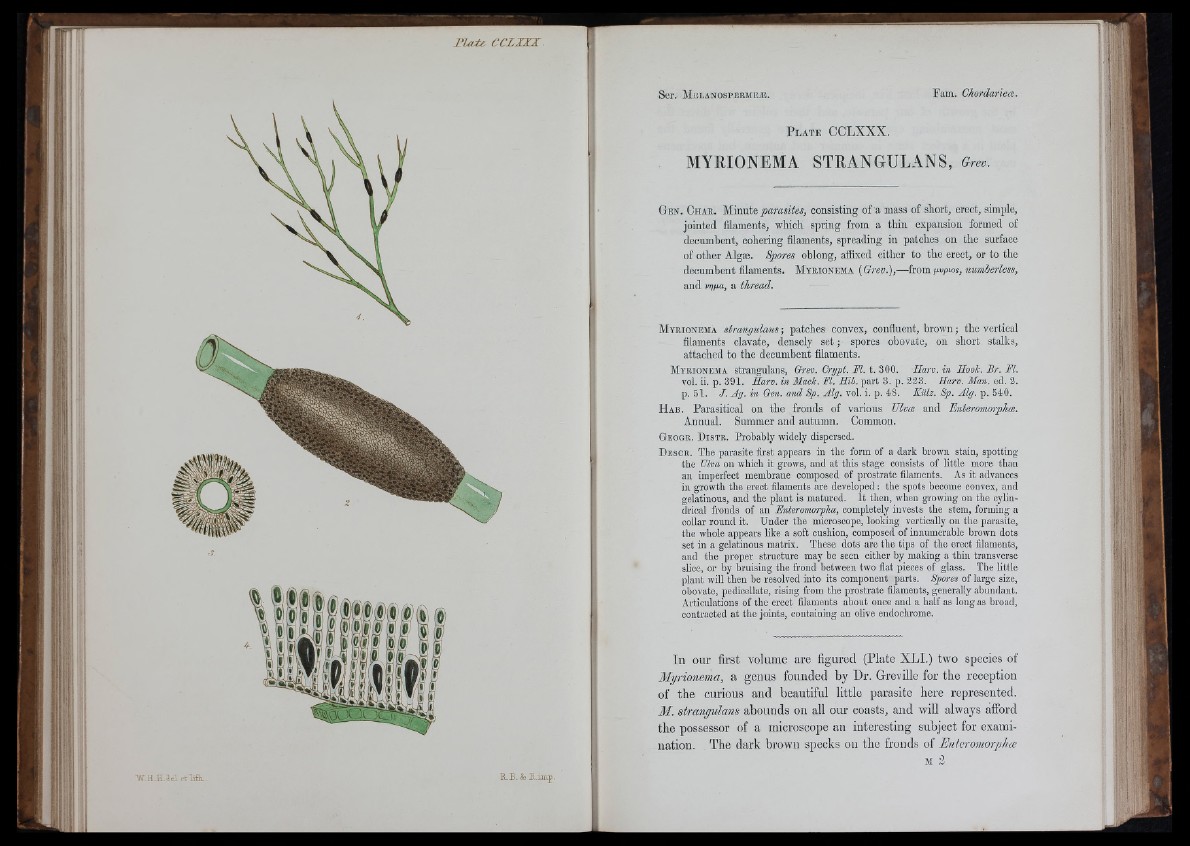
F u u c a z z i .
if f t k
P l a t e CCLXXX.
MYRIONEMA STRANGULANS, Grev.
G en. Ch a r . M.make parasites, consisting of a mass of short, erect, simple,
jointed fllaments, which spring from a thin expansion formed of
decumbent, cohering fllaments, spreading in patches on the surface
of other Algæ. Spores oblong, affixed either to the erect, or to the
decumbent filaments. M yrionema (Grev.),—from gopior, mmberless,
and vr)pa, a thread.
M yrionema strangulans ; patches convex, confluent, brown ; the vertical
filaments clavate, densely set ; spores obovate, on short stalks,
attached to the decumbent fllaments.
M y r i o n e m a strangulans, Grev. Crypt. FI. t. 300. ITarv. in Hook. Br. FI.
vol. ii. p. 391. Harv. in Mack. FI. Hib. part 3. p. 223. Harv. Man. ed. 2.
p. 51. J. Ag. in Gen. and Sp. Alg. vol. i. p. 48. Kütz. Sp. Alg. p. 540.
H a b . Parasitical on the fronds of various Ulva and Enteromorpha.
Annual. Summer and autumn. Common.
G e o g r . D i s t r . Probably widely dispersed.
D e s o r . Tbe parasite first appears in tbe form of a dark brown stain, spotting
the Ulva on which it grows, and at this stage consists of little more than
an imperfect membrane composed of prostrate filaments. As it advances
in growth the erect filaments are developed : the spots become convex, and
gelatinous, and the plant is matured. It then, when growing on the cylindrical
fronds of an Enteromorpha, completely invests the stem, forming a
collar round it. Under the microscope, looking vertically on the parasite,
the whole appears like a soft cushion, composed of innumerable brown dots
set in a gelatinous matrix. These dots are the tips of the erect filaments,
and the proper structure may be seen eitlier by making a thin transverse
slice, or by bruising the frond between two fiat pieces of glass. The little
plant will then be resolved into its component parts. Spores of large size,
obovate, pedicellate, rising from the prostrate filaments, generally abundant.
Articulations of the erect filaments about once and a half as long as broad,
contracted at the joints, containing an olive endochrome.
In our first volume are figured (Plate XLL) two species of
Myrionema, a genus founded by Dr. Greville for the reception
of the curious and beautiful little parasite here represented.
M. strangulans abounds on all our coasts, and will always afford
the possessor of a microscope an interesting subject for examination.
The dark brown specks on the fronds of Enteromorphce
M 2
' i